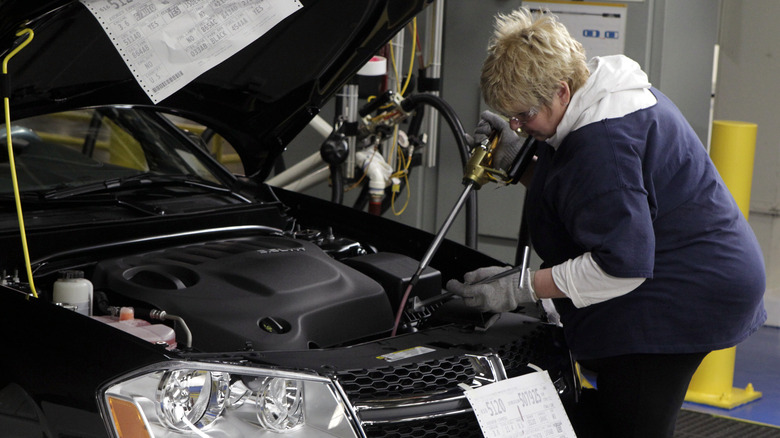How To Properly Check Your Car's Transmission Fluid Level
Some jobs are best left to the professionals, something we all tend to have to admit at some point in our lives. The trouble is, it can be difficult to determine just which jobs these are. Depending on your level of experience and confidence, there are cases where you may be able to save considerable money by taking on a maintenance task yourself. Consider your car's transmission fluid, for instance.
Without this viscous liquid, your transmission and your car's gears could essentially grind to a halt — perhaps literally without any lubrication. Though it isn't necessarily "used up" over time in the same way as fuel, fluid levels can begin to dwindle, and leaks can also occur. Insufficient transmission fluid levels can be incredibly dangerous, causing such issues as impaired braking and grinding sounds from your transmission that may be markedly different from the familiar engine hum from your vehicle.
Naturally, if you suspect there may be an issue with your vehicle, your first port of call will typically be your mechanic. In the interim, though, you can check your car's transmission fluid levels yourself. This article will provide step by step instructions on how to do just that, and what exactly it means if your transmission fluid is low, as well as detailing one important case in which you may not be able to check it yourself.
How to check your transmission fluid level
Perhaps you've noticed a sign that your transmission fluid may be low; these signs include slower gear changes and an ominous smell of burning caused by the transmission getting too hot. Maybe you're just working through your list of week in, week out checks on your car, like the super-responsible driver you are. In either case, here's the general process of checking your level of transmission fluid yourself.
-
With your vehicle safely parked and your engine running, extract the specific dipstick from your vehicle's transmission: you'll typically find it near the firewall under the hood.
-
Note the reading it gives you. If it's within the levels shown, there may be no further need to worry. If it's beneath them, a top-up or flush of the fluid could be in order.
-
Note the condition of the fluid: Whether it's gritty or not, and whether it's lighter or darker in color.
-
If the result is just between the levels shown and you're unsure, repeating the process again after giving the dipstick a quick clean is a great way to double-check your results.
-
Once you're sure of the reading, put the dipstick back and shut off your car.
Advertisement
These are the basics of checking your transmission fluid. What to do next, however, will depend on what you found while doing so.
Topping up and flushing transmission fluid
As noted in the instructions, it's important to check the consistency and coloring of the transmission fluid, as well as the level. This is because fluid that's in a poor condition can be as detrimental as fluid that's run low. As Car And Driver notes, a lighter red hue is indicative of "healthy" transmission fluid, while if it's closer to a darker brown — and/or if there are any gritty flecks in it — it may need to be flushed rather than simply topped up if low.
To add extra transmission fluid, you can simply use a funnel (consult your user manual to ensure you have the right fluid for your vehicle, as automatic and manual transmissions have different needs) while the dipstick is removed. Doing so slowly and steadily will ensure that you don't overfill. If the fluid is dirty or gritty, though, adding more could simply dilute the problem.
Flushing, or removing it all and starting again, could be the answer here. This is more of a specialized matter, though. The same goes for identifying any potential transmission damage, and whether this is the right thing to do in the first place, so consult your mechanic.
There's a last crucial thing to cover, though. Some car transmissions don't have the aforementioned dipstick. There's a very good reason for that.
A vital note on sealed transmission vehicles
Some car transmissions work similarly to things like a smartphone battery — they aren't generally intended to be opened up by the owner, especially if they don't have the expertise necessary to do so.
These, appropriately enough, are known as "sealed" transmissions, "lifetime" transmissions, or something similar. Though transmission fluid won't need to be changed very often, broadly speaking, it is still vulnerable to the sort of wear and tear that will dirty the transmission over time, as well as gradual depletion of fluid.
It's possible — and necessary at times — to change or replace the fluid of a sealed transmission, but this isn't recommended as an at-home job. The major difference is that the all-important dipstick isn't present in a sealed transmission, as it isn't designed to be monitored by the owner in the same way as other more traditional transmissions are.
With cases like these, and with the popularity of sealed transmissions in newer vehicles, your mechanic will be able to provide the best service. When it comes to your transmission fluid, then, the crucial thing is to know when you can check and rectify any issues with it yourself, and when you can't. An amateur touch could result in a much more expensive repair bill down the line.



